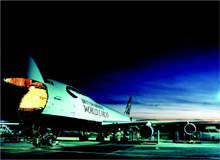
British Airways is one of the world’s largest international airlines, carrying around 36 million passengers worldwide, operating mainly from London’s Heathrow (the world’s biggest international airport) and Gatwick airports. It flies one of the largest fleets in Europe, with 289 aircraft, a mixture of Boeing and Airbus, as well as smaller aircraft used in the company’s regional business.
DEVELOPING THE ALLIANCE
As well as being a member of the oneworld alliance, British Airways franchise carriers GB Airways, British Mediterranean, Loganair, Sun Air and Comair add to the network and give the airline a presence in all major world markets. BA’s strategy for the future is focused on development of relationships within the oneworld alliance and its new members.
But how does BA evaluate which routes are likely to be profitable? “The strategy for any new route is that it has to be profitable and provide the most effective use of resources such as aircraft time and availability, flight and cabin crew rosters and airport slots,” says GM of network planning Lynne Embleton.
The analytical processes BA uses for route planning are as you would expect, involving passenger revenue and opportunities for cargo-carrying and code-sharing with other oneworld members. “We evaluate passenger and cargo demand, expected revenue and the cost of operating various types of aircraft on a specific route,” explains Embleton.
“This is done in conjunction with numerous departments including sales, revenue management and government affairs. Because we are not adding new aircraft to our fleet in the immediate future, starting a new route inevitably means reducing capacity elsewhere on the network. Therefore, it is a balancing act to ensure that we maximise profits. Obviously with any new route, extensive discussions take place with the airport authorities about our plans and how we can work together.”
How well do you really know your competitors?
Access the most comprehensive Company Profiles on the market, powered by GlobalData. Save hours of research. Gain competitive edge.

Thank you!
Your download email will arrive shortly
Not ready to buy yet? Download a free sample
We are confident about the unique quality of our Company Profiles. However, we want you to make the most beneficial decision for your business, so we offer a free sample that you can download by submitting the below form
By GlobalDataFrom an operational perspective, any changes to BA’s schedule involve a variety of departments including crew rostering, operations control and the relevant airport teams. “We also need to ensure that we have the necessary slots available for route changes,” says Embleton. “This is particularly important at congested airports, such as our base at Heathrow.”
BUSINESS CHALLENGES
Recent events, both terror-related and now the great Open Skies shake-up, have caused significant changes in the airline industry, though Embleton insists that BA’s core strategy remains largely unchanged. “Our network strategy remains focused on ensuring that we operate routes that make a profitable contribution to our business,” he says.
“On Open Skies, we welcome competition and believe we have an excellent combination of products, network and customer service. The London to US market is already highly competitive and offers customers a wide range of very good value-for-money fares.”
The European market, particularly the UK, has seen the emergence of one low-cost carrier after another, all trying to replicate the success of Michael O’Leary and Stelios Haji-Ioannou. BA has resisted the pressure to set up a no-frills carrier of its own and still provides some of the freebies that other national carriers have abandoned on short haul.
“Over the past few years we have combined the best of what we do well with the best of what the no-frills carriers do,” explains Embleton. “We fly from convenient airports and have an extensive network with frequent services. We also offer free food and drink onboard and pre-allocated seats.” BA’s pre-eminent position at London Heathrow is one of its major selling points; this can only improve further with the move to Terminal 5 next year.







